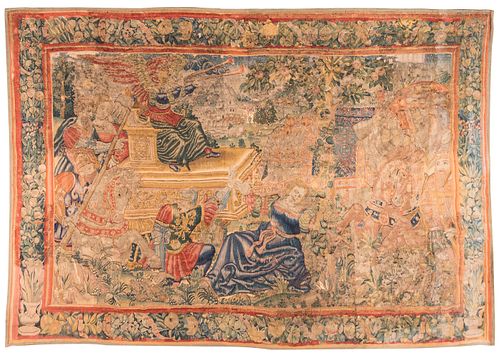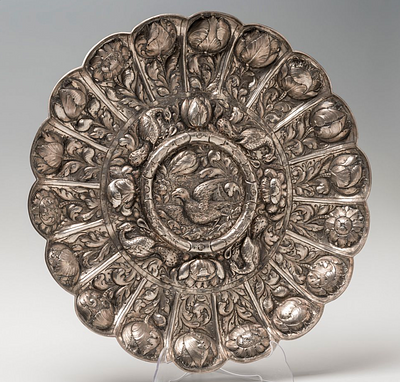Tapestry; Flemish workshop, first half of the seventeenth century. "King David bringing the ark from Jerusalem".
Lot 44
About Seller
Setdart Auction House
Carrer Aragó 346
Barcelona
Spain
Setdart Subastas was born in 2004 and is currently the first online art auction in Spain with solidity, prestige and reliability guaranteed by our more than 60,000 users. Setdart has a young, dynamic and enterprising team ready to successfully manage the purchase and sale of art works through custom...Read more
Categories
Estimate:
EUR€3,500 - EUR€4,000
$3,763.44 - $4,301.08
Absentee vs Live bid
Two ways to bid:
- Leave a max absentee bid and the platform will bid on your behalf up to your maximum bid during the live auction.
- Bid live during the auction and your bids will be submitted real-time to the auctioneer.
Bid Increments
| Price | Bid Increment |
|---|---|
| EUR€0 | EUR€10 |
| EUR€200 | EUR€25 |
| EUR€500 | EUR€50 |
| EUR€1,000 | EUR€100 |
| EUR€3,000 | EUR€200 |
| EUR€5,000 | EUR€500 |
| EUR€10,000 | EUR€1,000 |
| EUR€20,000 | EUR€2,000 |
| EUR€50,000 | EUR€5,000 |
About Auction
By Setdart Auction House
Jul 13, 2021
Set Reminder
2021-07-13 07:00:00
2021-07-13 07:00:00
America/New_York
Bidsquare
Bidsquare : DECORATIVE ARTS XV-XIX
https://www.bidsquare.com/auctions/setdart-auction-house/decorative-arts-xv-xix-7201
Setdart Auction House sofia@setdart.com
Setdart Auction House sofia@setdart.com
- Lot Description
Tapestry; Flemish workshop, first half of the seventeenth century. "King David bringing the ark from Jerusalem". Wool. It presents damages, lack of lining, old restorations and re-done areas. Measurements: 271 x 391 cm. Due to the technical characteristics of this tapestry, it is probable that it is linked to the manufactures of central Europe, or to Spain, since this country had a very close political and commercial relationship with Flanders until the 18th century. These characteristics are based on a large border that frames and delimits the interior in a very theatrical way, and a representation of a narrative scene with themes, mostly of a historical, religious or mythological nature. These features can be seen in the tapestry presented here. In the central scene there are several characters whose names accompany them: fame, who is represented as well as a trumpet angel, seated on a throne, Portia (which can be understood as Portia), located in the center of the composition, and on the sides Judas Maccabeus and King David. All of them characters recognized by the Christian religion for their faith and defense of religious values. It is interesting that the figure of fame is that of an angel playing a trumpet, since this representation is associated with the archangel Saint Gabriel and his announcement of the end of the world. So it is probable that the tapestry acquires a moralistic message, showing the spectator that fame and recognition are obtained after death, as a reward for an exemplary and devout life. All the characters are surrounded by a profuse landscape, dominated by vegetation, as well as the border, which is composed only of fruit and leaves, except for the two amphorae in the lower corners. This type of scene is known as verdure or millefleur. This style is characterized by the use of a large number of plants or flowers of different sizes. In many occasions these are arranged in the lower area, and are placed in an ascending way creating a vegetation scenery. While on other occasions it is the representation of realistic scenes whose protagonist is the landscape. It is a very common style in Europe, which began to develop in the Middle Ages. Tapestry is relatively fragile and difficult to make, so most historical pieces are intended to hang vertically on a wall, or sometimes horizontally on a piece of furniture such as a table or bed. In some periods, smaller pieces, often long and narrow, were made and used as borders for other textiles. Thus, European tapestries are usually made to be viewed only from one side and often have a plain lining added to the back.
- Shipping Info
-
In-house shipping available. Please inquire at admin@setdart.com.
-
- Buyer's Premium



 EUR
EUR CAD
CAD AUD
AUD GBP
GBP MXN
MXN HKD
HKD CNY
CNY MYR
MYR SEK
SEK SGD
SGD CHF
CHF THB
THB

















